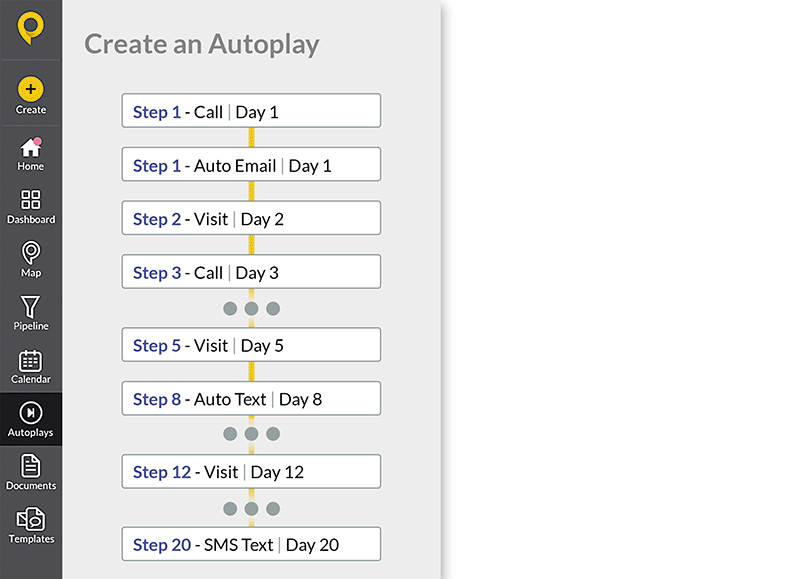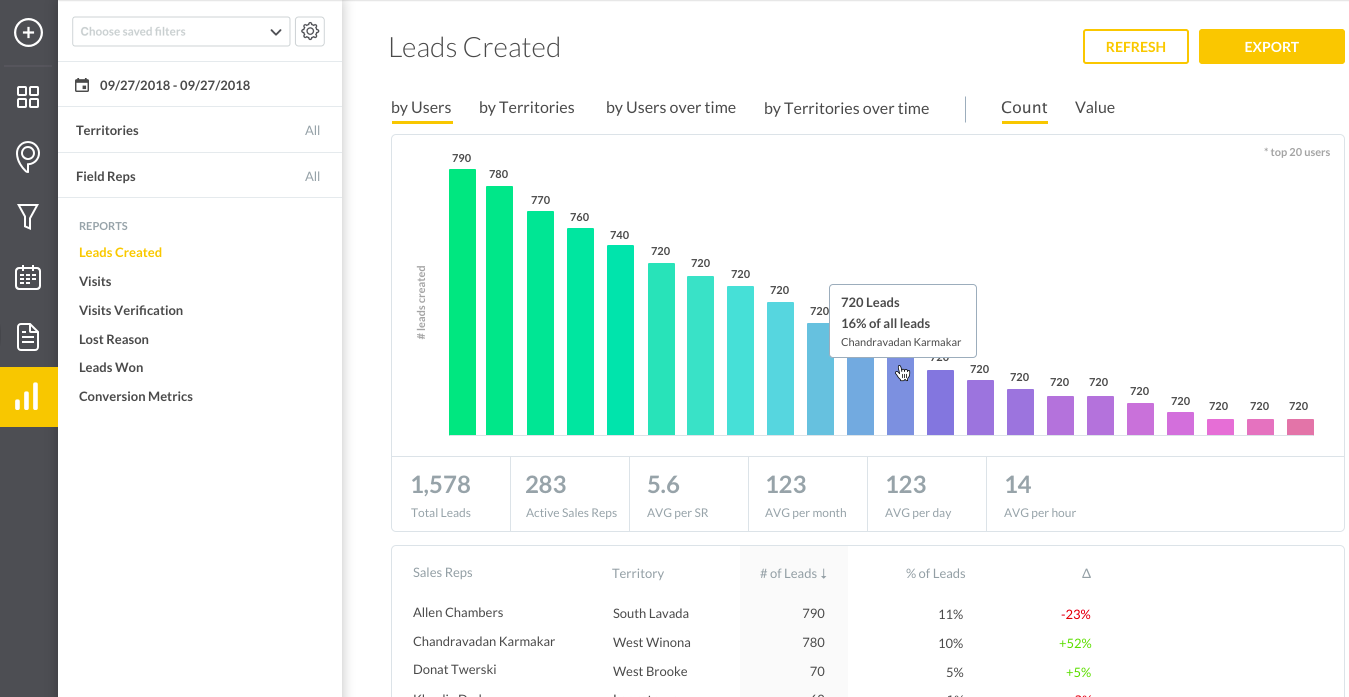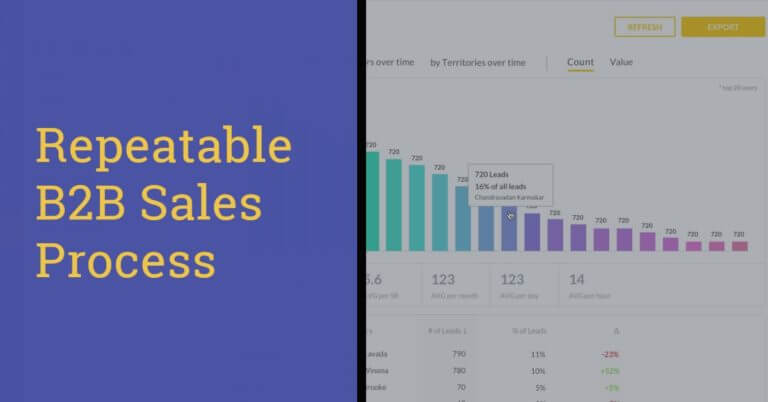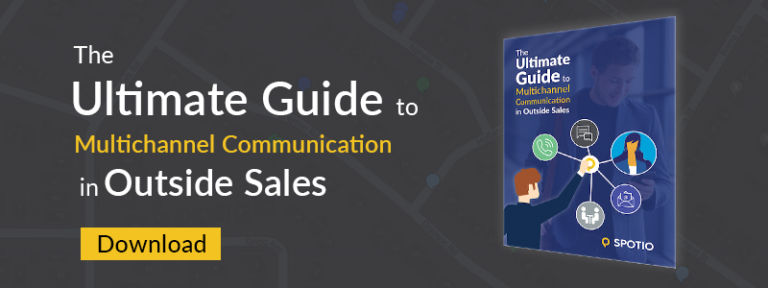We won’t beat around the bush: B2B sales is complex.
To succeed in this space, you need to work hard, experiment with new strategies, and develop a winning B2B sales process that your reps can easily implement.
That’s where we come in! Keep reading to learn the main differences between B2B sales and B2C sales, the foundations of the modern B2B selling process, and how to create a B2B sales model for your company that will reliably generate leads and revenue.
The Main Differences Between B2B and B2C Sales?
B2B, “Business-to-Business, ” is used to describe companies that sell products and/or services to other companies. This is different from B2C, which stands for “Business to Consumer,” and describes companies that sell products and services to individuals.
So, the main difference between B2B and B2C is the end buyer. Because of this, B2B and B2C sales vary from each other in a few important ways:
- Price Points: B2B products and services are often more expensive than B2C products and services. This is because B2B offerings are designed to streamline business processes, increase revenue, etc., which have tangible benefits.
- Stakeholders: To sell a B2B product or service, a sales rep usually has to convince multiple people that their offering is the best. According to Gartner, the average B2B deal requires 6 to 10 decision makers. Most B2C deals require one.
- Touchpoints: Because B2B products/services are more expensive and require approval from multiple stakeholders, there are often more touchpoints in the B2B sales process. Customers need to review details, host internal meetings, etc., before buying.
- Sales Cycles: Higher price points and multiple stakeholders also lead to longer sales cycles. 75% of B2B deals to new customers take four months to close. B2C deals might take a few minutes to close if the offer, price point, and timing are right.
As you can see, B2B and B2C sales are pretty different. As such, the B2B sales process is pretty different from the B2C one. Let’s dive into that a bit more…
Foundations of the Modern B2B Selling Process
The sales process for B2B companies is unique.
As a B2B seller, you’ll likely sell higher-priced products and services and deal with multiple stakeholders and touchpoints—all of which will lead to longer average sales cycles.
To succeed in this field, you need to build a rock-solid B2B sales process. Don’t worry; it’s not as hard as it sounds. Just make sure your process is:
Customer-Centric: An effective B2B selling process aligns with customer needs and behaviors. Just remember, said needs and behaviors change. So your process should, too.
Goal-Driven: Your B2B sales model should aim to accomplish specific things, like “increase revenue” or “increase efficiency“. With clear goals, your sales department will stay strong.
Defined Sales Cycle: Do your sales reps understand every stage in your B2B sales cycle? They will if you clearly define each stage for your team. Make sure your process is clear.
Repeatable: The best B2B sales processes can be easily replicated. This enables everyone on your team, from your newest sellers to your grizzled veterans, to consistently perform.
Predictable: Repeatable sales processes lead to predictability. Your B2B sales model should follow a consistent pattern, which, when adhered to, will produce expected results.
Measurable: Finally, make sure your sales process for B2B can be measured. Attach a KPI to every sales activity in your process so that you can accurately assess it for effectiveness.
How to Build a Winning B2B Sales Process
Once you build an effective B2B sales process for your company, you’ll connect with more customers, close more deals, and create happier sales reps. Here’s how to get it done:
Define Your Ideal Customer Profile
An ideal customer profile, ICP for short, is a fictional company that will benefit from the products and/or services you sell. You can use your ICP for prospecting purposes.
Here’s the thing: you might sell the greatest thing since sliced bread. But that doesn’t mean every brand will want to buy it. Instead of trying to convert every company into a customer, focus on the businesses that are most likely to buy, AKA the brands represented by your ICP.
To create an ICP for your sales department, scan through your list of current customers and find common attributes. Then conduct deep research to learn about these companies’ industries, budgets, challenges, etc. Lastly, assemble this information into a template.
Once you’ve created an ICP, instruct your sales reps to only target prospects that match it.
Map Out the Buying Process
Now that you know who your target customers are map out the buying process for them. Simply put, how do you transform total strangers into paying customers?
To make this step easier, ask yourself the following six questions:
- Who is involved in the buying process?
- How do sales reps reach these individuals?
- How do sales reps build trust with these individuals?
- How many customer touchpoints does the process need?
- What challenges do our offerings help customers overcome?
- What is the end result for customers who use our products/services?
Answering these questions will help you design a journey for your customers that leads them through the various stages of the B2B sales process.
Identify Your Macro and Micro Sales Channels
At this point, you’ve determined who your audience is and how you’ll turn them into paying customers. Next, decide the macro and micro channels you’ll use to reach them.
- Macro Channels: Are you going to use an inside, outside, or hybrid sales approach?
- Micro Channels: Are you going to use in-person visits, the phone, emails, text messages, social media, video marketing, etc., to reach potential customers?
It’s important to define your channels. Doing so will help you set goals, plan sales strategies, create content, and do everything else you need to do for your B2B sales model to work.
Develop Sales Enablement Content
Studies show that content marketing efforts can directly affect sales. The most successful B2B marketing organizations spend 39% of their budgets on content, while less successful ones spend 22%.
To develop top-quality sales enablement content, you need to make sure your company’s sales and marketing departments are aligned. Are both teams working towards the same goals? Are they in constant communication with each other? They should be!
Once Marketing and Sales are aligned, you’ll be able to create blog posts, eBooks, white papers, case studies, videos, etc., that help drive revenue growth.
Set SMART Sales Goals
You wouldn’t drive from San Francisco, CA, to New York City without GPS, would you? Of course not. It would be too easy to get lost along the way.
Your B2B sales process is similar. You need to know where you’re going so that you can plan an efficient route to your destination. In other words, you need SMART sales goals:
- Specific: Your goal should be incredibly specific. You’re not trying to “connect with more prospects.” You’re trying to “contact 50 new prospects a day”.
- Measurable: Your goal should be measurable. You’re not trying to “boost sales numbers.” You’re trying to “boost sales numbers by 10%”.
- Attainable: Your goal should be something you can realistically achieve. You’re not trying to “attain a 100% close rate”. You’re trying to “raise close rates by 5%.”
- Relevant: Your goal should match overarching company goals. You’re not trying to “increase thought leadership.” You’re trying to “convert more prospects.”
- Time-Related: Your goal should have a deadline. You’re not trying to “reach one million in sales.” You’re trying to “reach one million in sales by December 31st”.
Assign Minimum Daily Sales Activities
Your reps can’t control who buys from them and who doesn’t. But they can control their actions and levels of effort. That’s why we suggest building minimum daily sales activities (making calls, sending follow-up emails, etc.) into your B2B sales process.
This is really easy to do with a tool like SPOTIO.
Design entire sales workflows with our software’s Autoplays feature and send reps automated activity reminders. That way, they always know what to do and when to do it. Then check up on them with SPOTIO’s real-time feeds to make sure they’re on track.

Nail Your Pitch
You’ve accomplished a lot so far, and your B2B selling process is really starting to take shape. What’s next? It’s time to focus on the pitch your reps will give to potential customers.
The best sales pitches are personalized. Your reps need to understand who their prospects are, the specific things each prospect struggles with, and how the products/services they sell can help. Then they need to convey this information in a simple, concise manner.
Remind your reps to focus on benefits, not features. Nobody cares that your offering can do ABC. They care that doing ABC will help them accomplish XYZ. That’s the key.
Prepare For Objections
Every sales rep, no matter how talented they are, deals with objections on a daily basis.
The prospect might be happy with their current provider. Or short on funds. Maybe they just doubt that your company can deliver on the promises it makes to customers.
The best way to handle objections is to prepare for them ahead of time. Chances are, most of the prospects your reps talk to have similar complaints. Devise ways to overcome them.
And advise your reps never to disregard an objection. This will make them seem rude and automatically turn away potential buyers. Instead, ask your reps to listen to every objection that comes their way, then reposition their offers to address each concern.
Follow Up With Qualified Leads
Do you know what’s crazy? Only 2% of sales happen during the first point of contact, but 44% of sales reps give up after a prospect turns them down one time.
If your B2B sales process doesn’t include a follow-up routine, you’re leaving money on the table. Boatloads of it. Fortunately, following up really isn’t that difficult.
All you have to do is schedule emails to send every couple of weeks. Or set reminders to call prospects again after a month or two has gone by. Or connect with them on LinkedIn and comment on their posts from time to time. Or stop by their office whenever you’re in the area.
SPOTIO simplifies the follow-up process. Use our platform to schedule emails and text messages at ideal times based on the data collected and stored in your company’s account.
Close the Deal
Next up in your B2B sales process: closing the deal.
If you’ve done everything else we’ve talked about in this article, the close should be simple and straightforward. After all, you’ve already identified quality prospects, engaged them with awesome content, nailed your pitch, handled objections, followed up, etc.
Your reps’ job at this point is to not screw it up. Make sure they answer every question their prospects still have, deliver a quality proposal, and do whatever else is needed.
Nurture Your Customers
BOOM! All of your hard work is starting to pay off, and your reps are converting prospects into customers at a respectable pace. Yes, your B2B selling process is crushing it!
Congratulations, this is great news, but don’t take your foot off the gas pedal just set. Your B2B sales cycle should include post-sales steps, too. Mainly, you want your reps to stay in touch with customers and build deep relationships with them to stimulate future sales.
Happy customers can be approached for reviews, testimonials, and case studies—each of which play an important role in B2B sales. They’re also perfect upsell and cross sell targets.
In an ideal scenario, the sale will be the beginning of the customer relationship, not the end.
Track Activity and Performance Metrics
Finally, track your sales reps’ efforts and the results they achieve. Doing so will help you identify top sellers, optimize your sales strategy, and, ultimately, generate more revenue.
How many prospects do your reps contact on a daily basis? What channels do they use most frequently? What’s their success rate? Which stages of your B2B sales process cause friction and extend the sales cycle? What can you do to eliminate sticking points?
SPOTIO is equipped with a powerful sales tracking feature, which will give you the insights you need to make better decisions and lead your department with confidence.

Power Your B2B Outside Sales Process With SPOTIO
The truth is, you need to develop a B2B sales process that your reps can rely on. Once you do, your company will connect with higher quality leads, convert more leads into paying customers, and ensure said customers’ loyalty—all while reducing employee turnover.
The good news is, developing a proven B2B sales model isn’t rocket science. We just gave you everything you need to build an effective and repeatable process for your team.
Here’s one more tip: invest in a quality piece of software to make B2B sales easier. If you manage a field sales team, SPOTIO is the clear option. With it, you’ll be able to pinpoint prospects, automate communication with them, track rep activity and performance, and more.
Sign up for a free demo of SPOTIO today to see our industry-leading platform in action!



